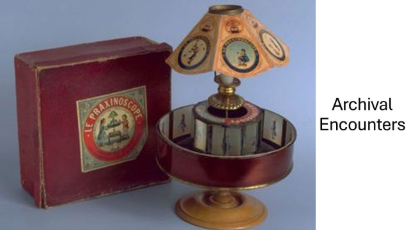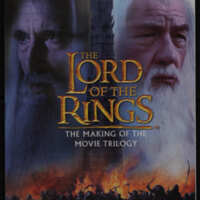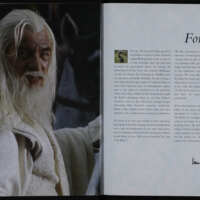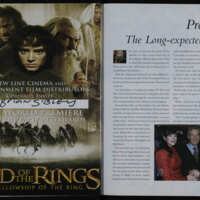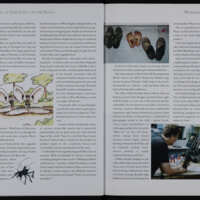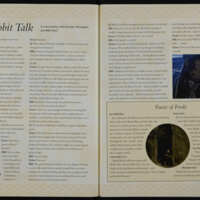The Lord of the Rings: The Making of the Movie Trilogy.
Dublin Core
Title
The Lord of the Rings: The Making of the Movie Trilogy.
Subject
A book focusing on the making of Peter Jackson’s Lord of the Rings Trilogy, filmed in New Zealand from 1999-2003.
Description
The Lord of the Rings: The Making of the Movie Trilogy (EXE BD 37689; 2002) is a companion book to Peter Jackson’s The Lord of the Rings Trilogy, although was published specifically to coalesce with the December release of The Two Towers (2002), the trilogy’s second instalment. Published merely a month before its theatrical release, it encapsulates the production of all three films, featuring cast interviews and over 300 photographs of cast members, pre-production stills of models, comic sketches, makeup venues, costume designs and the New Zealand Symphony Orchestra. It opens with a descriptive account of the first film’s world premiere and its Cannes Film Festival debut, before offering a timeline of the trilogy’s technical development, comprised of personal anecdotes.
While written by a solo author, as with other companion pieces in this collection- such as Arthur C. Clarke’s The Lost Worlds of 2001 (EXE BD 38364)- unlike such examples, this artefact is a collaborative piece. It documents the experiences of the entire cast and crew, accentuating the scale of the trilogy’s production over its narrative. While the text is guided by the “printed word” on every page, it is overwhelmingly pictorial, contextualising the trilogy’s visual essence. Phil Wickham emphasises that archived ephemera can “give us a sense of what Williams described as ‘lived culture’ deriving from the ‘structures of feeling’ of the time”, and this is the book’s primary purpose (Wickham; 315-330; 2010). It is less preoccupied with uncovering lost histories and more preoccupied with distilling the “structures of feeling” which enveloped the trilogy’s production. This is indicated by the timing of the artefact’s release. Published almost a full year after the release of the first film, The Fellowship of the Ring (2001), it was created for a pre-existing audience already familiar with Jackson’s trilogy, yet it was also published over a year before The Return of the King (2003) to cultivate audience anticipation. As an artefact, the book does not offer a retrospective or an alternative history, but instead a receptacle for the “lived culture” created by the films on their release.
After a foreword by Ian McKellen- describing Sibley’s text as the “most authoritative source” on “what it was really like” making the films- Sibley’s prologue outlines the first film’s premiere. However, rather than documenting it retrospectively, he accentuates the event’s “structures of feeling” via simile and narrates it in the present tense, “It’s like a scene out of a movie” (Sibley; 2002; 9). In this meta-description, the film and the premiere effectively become one; the films and their “lived culture” reciprocate and enliven one another.
The prologue is situated next to a full-page photograph of New Line Cinema’s invitation addressed in handwriting to Sibley to attend the world premiere, itself a piece of deliberately placed ephemera accentuating the prevalence of Jackson’s trilogy in the public consciousness. Whickham also observes that Total Film’s 2009 ‘iconic poster’ calendar (EXE BD 55209) in the Bill Douglas Cinema Museum (BDCM) features Jackson’s trilogy to “appeal to the consumer’s recent memory…The purchaser of the calendar buys into the historical weight of the popularity and influence…” (ibid), and the photographed ephemera here serves a similar purpose in the catalogue. A photo of a then-recently handwritten invitation is given great weight in taking up an entire page. The film’s premiere is framed as a culturally significant and celebratory event, increased by the then-common notion that Tolkien’s books could not be translated to cinema. English scholar Kim Selling has noted that Jackson and his production team knew that the books were ‘unfilmable’ without transformation (Selling; 46-67; 2021), and although this artefact celebrates the trilogy’s “lived culture”, it occasionally subsequently hints at an alternative “dead” culture in which the films were not made.
The artefact documents the technical minutia behind the trilogy’s creation, and, in doing so, reveals the strenuousness behind the production. The subsequent Workshop of Wonders chapter discusses how integral the digital visual effects company Weta Workshop- co-founded in 1993 by Peter Jackson, eight years before the first film’s release- was in realising Jackson’s Middle-Earth. Here, the artefact offers additional glimpses into revealing ephemera and memorabilia. It cites a “Weta Calendar” featuring cartoons by Chris Guise, one of which shows Jackson being approached by versions of Frodo and Sam with bafflingly huge hobbit ears and feet, asking with a panicked expression “Ah…What scale are we shooting at here?” (Sibley; 2002; 20). It was initially possible for such pioneering technical edits to go seriously wrong given their relative infancy in the industry; as Richard Taylor, then head of Weta Workshop, remarks in Sibley’s book, “…there’s not more than a handful of scenes in the entire film that don’t feature a Weta product!” (21).
Similarly, the artefact outlines the true reason for New Line Cinema’s involvement, revealing the production’s initial precarity. Miramax Studios were concerned by the trilogy’s escalating projected costs, and issued an ultimatum declaring that The Lord of the Rings be edited into a single film. A proposal which almost resulted in the production’s complete collapse. New Line Cinema- the very company responsible for Sibley’s invite on the opening page- provided funding for a trilogy and saved the production, making it "filmable". Sibley remarks that the workshop seemed “born and bred to survive” (25); instead of simply celebrating the trilogy, the artefact reveals the extent to which the “lived culture” it captures nearly never came to fruition, evolving in a continual state of “survival”.
However, this extent is fleetingly captured, courtesy of the artefact being largely pictorial, technical, and light on narrative focus. The remainder of Sibley’s book emphasises the artefact as a collaborative creation. It focuses on interviews with Dominic Monaghan, Billy Boyd and Viggo Mortensen, pre/post-production details for CGI, blue screen and motion capture, and the creative process behind Howard Shore’s score. A clear contrast within the collection is apparent in Ernest Lehman’s West Side Story (EXE BD 31490), released in 2003 a mere year later. Like Sibley’s Making of the Movie Trilogy, it includes multiple stills, promotional pictures, and information on the making of the film via the Lobby Brochure, with both made for pre-existing fans. Yet the West Side Story artefact contains the film’s full screenplay, contextualised by accompanying film reviews- neither of which feature in Sibley’s book. This is attributable to Lehman’s book being a personal instead of collaborative retrospective penned by the film’s author decades later, with more contextual resources at his disposal and a greater temporal coverage of 40 years. The Making of the Movie Trilogy may be more successful in capturing the “lived culture” generated by Jackson’s trilogy, insofar as the artefact coincides with its release. But in the same breath, it is more narratively limited, discussing two films yet to have been theatrically released and seen by the public.
As such, the artefact accompanies a unique place in this collection. Unlike The Lost Worlds of 2001, it is a collaborative and pictorial instead of prosaic companion piece, and more easily summarised by a general observer. Likewise, unlike West Side Story, it exists not to offer a thorough narrative retrospective of a 40-year-old classic, but instead to capture- via extensive photography, ephemera and second-hand accounts from the cast and crew- a then-occurring lived cinematic culture in which Jackson’s trilogy dominated the popular zeitgeist, cumulatively grossing $3.004 billion at the worldwide box office. Beyond this, the artefact also documents how this culture came to fruition and avoided an early demise, outlining the challenges involved in filming what was then presumed “unfilmable”.
Works Cited
Clarke, Arthur C. 1972. “The Lost Worlds of 2001”. BDCM Entry 38364. Accessed 17/11/2023. https://www.bdcmuseum.org.uk/explore/item/38364/
Lehmann, Ernest. 2003. “West Side Story”. BDCM entry 31490. Accessed 29/11/2023. https://www.bdcmuseum.org.uk/explore/item/31490/
Total Film. 2009. “Iconic Poster Calendar”. BDCM entry 55209. Accessed 09/12/2023
Selling, Kim. 2021. “J.R.R Tolkien’s The Lord of the Rings: The Book, the Film, and Genre Criticism”. Sydney Studies in English. 29: pp. 46–67.
Sibley, Brian. 2002. “The Lord of the Rings: The Making of the Movie Trilogy”. BDCM entry 37689. Accessed 17/11/2023
Sibley, Brian. 2002. “The Lord of the Rings: The Making of the Movie Trilogy”. HarperCollinsPublishers, 77-85 Fulham Palace Road, Hammersmith, London.
Wickham, Phil. 2010. “Scrapbooks, soap dishes and screen dreams: ephemera, everyday life and cinema history”, New Review of Film and Television Studies, 8:3, pp. 315-330, DOI: 10.1080/17400309.2010.499775
While written by a solo author, as with other companion pieces in this collection- such as Arthur C. Clarke’s The Lost Worlds of 2001 (EXE BD 38364)- unlike such examples, this artefact is a collaborative piece. It documents the experiences of the entire cast and crew, accentuating the scale of the trilogy’s production over its narrative. While the text is guided by the “printed word” on every page, it is overwhelmingly pictorial, contextualising the trilogy’s visual essence. Phil Wickham emphasises that archived ephemera can “give us a sense of what Williams described as ‘lived culture’ deriving from the ‘structures of feeling’ of the time”, and this is the book’s primary purpose (Wickham; 315-330; 2010). It is less preoccupied with uncovering lost histories and more preoccupied with distilling the “structures of feeling” which enveloped the trilogy’s production. This is indicated by the timing of the artefact’s release. Published almost a full year after the release of the first film, The Fellowship of the Ring (2001), it was created for a pre-existing audience already familiar with Jackson’s trilogy, yet it was also published over a year before The Return of the King (2003) to cultivate audience anticipation. As an artefact, the book does not offer a retrospective or an alternative history, but instead a receptacle for the “lived culture” created by the films on their release.
After a foreword by Ian McKellen- describing Sibley’s text as the “most authoritative source” on “what it was really like” making the films- Sibley’s prologue outlines the first film’s premiere. However, rather than documenting it retrospectively, he accentuates the event’s “structures of feeling” via simile and narrates it in the present tense, “It’s like a scene out of a movie” (Sibley; 2002; 9). In this meta-description, the film and the premiere effectively become one; the films and their “lived culture” reciprocate and enliven one another.
The prologue is situated next to a full-page photograph of New Line Cinema’s invitation addressed in handwriting to Sibley to attend the world premiere, itself a piece of deliberately placed ephemera accentuating the prevalence of Jackson’s trilogy in the public consciousness. Whickham also observes that Total Film’s 2009 ‘iconic poster’ calendar (EXE BD 55209) in the Bill Douglas Cinema Museum (BDCM) features Jackson’s trilogy to “appeal to the consumer’s recent memory…The purchaser of the calendar buys into the historical weight of the popularity and influence…” (ibid), and the photographed ephemera here serves a similar purpose in the catalogue. A photo of a then-recently handwritten invitation is given great weight in taking up an entire page. The film’s premiere is framed as a culturally significant and celebratory event, increased by the then-common notion that Tolkien’s books could not be translated to cinema. English scholar Kim Selling has noted that Jackson and his production team knew that the books were ‘unfilmable’ without transformation (Selling; 46-67; 2021), and although this artefact celebrates the trilogy’s “lived culture”, it occasionally subsequently hints at an alternative “dead” culture in which the films were not made.
The artefact documents the technical minutia behind the trilogy’s creation, and, in doing so, reveals the strenuousness behind the production. The subsequent Workshop of Wonders chapter discusses how integral the digital visual effects company Weta Workshop- co-founded in 1993 by Peter Jackson, eight years before the first film’s release- was in realising Jackson’s Middle-Earth. Here, the artefact offers additional glimpses into revealing ephemera and memorabilia. It cites a “Weta Calendar” featuring cartoons by Chris Guise, one of which shows Jackson being approached by versions of Frodo and Sam with bafflingly huge hobbit ears and feet, asking with a panicked expression “Ah…What scale are we shooting at here?” (Sibley; 2002; 20). It was initially possible for such pioneering technical edits to go seriously wrong given their relative infancy in the industry; as Richard Taylor, then head of Weta Workshop, remarks in Sibley’s book, “…there’s not more than a handful of scenes in the entire film that don’t feature a Weta product!” (21).
Similarly, the artefact outlines the true reason for New Line Cinema’s involvement, revealing the production’s initial precarity. Miramax Studios were concerned by the trilogy’s escalating projected costs, and issued an ultimatum declaring that The Lord of the Rings be edited into a single film. A proposal which almost resulted in the production’s complete collapse. New Line Cinema- the very company responsible for Sibley’s invite on the opening page- provided funding for a trilogy and saved the production, making it "filmable". Sibley remarks that the workshop seemed “born and bred to survive” (25); instead of simply celebrating the trilogy, the artefact reveals the extent to which the “lived culture” it captures nearly never came to fruition, evolving in a continual state of “survival”.
However, this extent is fleetingly captured, courtesy of the artefact being largely pictorial, technical, and light on narrative focus. The remainder of Sibley’s book emphasises the artefact as a collaborative creation. It focuses on interviews with Dominic Monaghan, Billy Boyd and Viggo Mortensen, pre/post-production details for CGI, blue screen and motion capture, and the creative process behind Howard Shore’s score. A clear contrast within the collection is apparent in Ernest Lehman’s West Side Story (EXE BD 31490), released in 2003 a mere year later. Like Sibley’s Making of the Movie Trilogy, it includes multiple stills, promotional pictures, and information on the making of the film via the Lobby Brochure, with both made for pre-existing fans. Yet the West Side Story artefact contains the film’s full screenplay, contextualised by accompanying film reviews- neither of which feature in Sibley’s book. This is attributable to Lehman’s book being a personal instead of collaborative retrospective penned by the film’s author decades later, with more contextual resources at his disposal and a greater temporal coverage of 40 years. The Making of the Movie Trilogy may be more successful in capturing the “lived culture” generated by Jackson’s trilogy, insofar as the artefact coincides with its release. But in the same breath, it is more narratively limited, discussing two films yet to have been theatrically released and seen by the public.
As such, the artefact accompanies a unique place in this collection. Unlike The Lost Worlds of 2001, it is a collaborative and pictorial instead of prosaic companion piece, and more easily summarised by a general observer. Likewise, unlike West Side Story, it exists not to offer a thorough narrative retrospective of a 40-year-old classic, but instead to capture- via extensive photography, ephemera and second-hand accounts from the cast and crew- a then-occurring lived cinematic culture in which Jackson’s trilogy dominated the popular zeitgeist, cumulatively grossing $3.004 billion at the worldwide box office. Beyond this, the artefact also documents how this culture came to fruition and avoided an early demise, outlining the challenges involved in filming what was then presumed “unfilmable”.
Works Cited
Clarke, Arthur C. 1972. “The Lost Worlds of 2001”. BDCM Entry 38364. Accessed 17/11/2023. https://www.bdcmuseum.org.uk/explore/item/38364/
Lehmann, Ernest. 2003. “West Side Story”. BDCM entry 31490. Accessed 29/11/2023. https://www.bdcmuseum.org.uk/explore/item/31490/
Total Film. 2009. “Iconic Poster Calendar”. BDCM entry 55209. Accessed 09/12/2023
Selling, Kim. 2021. “J.R.R Tolkien’s The Lord of the Rings: The Book, the Film, and Genre Criticism”. Sydney Studies in English. 29: pp. 46–67.
Sibley, Brian. 2002. “The Lord of the Rings: The Making of the Movie Trilogy”. BDCM entry 37689. Accessed 17/11/2023
Sibley, Brian. 2002. “The Lord of the Rings: The Making of the Movie Trilogy”. HarperCollinsPublishers, 77-85 Fulham Palace Road, Hammersmith, London.
Wickham, Phil. 2010. “Scrapbooks, soap dishes and screen dreams: ephemera, everyday life and cinema history”, New Review of Film and Television Studies, 8:3, pp. 315-330, DOI: 10.1080/17400309.2010.499775
Creator
Brian Sibley
Source
The Lord of the Rings Trilogy (Directed by Peter Jackson; 2001-2003).
Publisher
HarperCollinsPublishers 2002
Date
Published on November 6th, 2002
Contributor
Ruben Martin-Ward
Rights
Photographs, Stills, Film Logos © 2002 New Line Cinema Productions, Inc.
All Rights Reserved
Photographs on pages 184, 185. 187 (bottom) and 188 © 2002 Robert Catto/ Film Wellington.
All Rights Reserved.
Compilation © HarperCollinsPublishers 2002
Brian Sibley asserts the moral right to be identified as the author of this work.
All rights reserved. No part of this publication may be reproduced, stored in a retrieval system, or transmitted, in any form or by any means, electronic, mechanical, photocopying, recording or otherwise, without the prior permission of the publishers.
All Rights Reserved
Photographs on pages 184, 185. 187 (bottom) and 188 © 2002 Robert Catto/ Film Wellington.
All Rights Reserved.
Compilation © HarperCollinsPublishers 2002
Brian Sibley asserts the moral right to be identified as the author of this work.
All rights reserved. No part of this publication may be reproduced, stored in a retrieval system, or transmitted, in any form or by any means, electronic, mechanical, photocopying, recording or otherwise, without the prior permission of the publishers.
Format
Book 0.5 x 8.6 x 11.2 cm
Language
English
Type
A companion book
Identifier
ISBN 0 00 713567 X (trade paperback- archived in BDCM)
ISBN 0 00 712302 7 (collector’s hardback)
ISBN 0 00 712302 7 (collector’s hardback)
Coverage
The Making of the Lord of the Rings Trilogy, New Zealand, 1999-2003.
Publishing of artefact: Hammersmith, London, 2002
Publishing of artefact: Hammersmith, London, 2002
Text Item Type Metadata
Text
192 pages
Original Format
Paper
Collection
Citation
Brian Sibley, “The Lord of the Rings: The Making of the Movie Trilogy.,” Archival Encounters: Digital Exhibitions form the Bill Douglas Cinema Museum, accessed July 5, 2025, https://humanities-research.exeter.ac.uk/archivalencounters/items/show/38.
